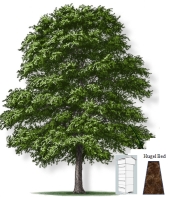Before I start, I hope you realize that colonies that escape can find places with a pretty complicated design to raise their queen and make honey, like in between the studs of a poorly insulated building, or under a roof, and a few of them make it over winter sometimes, so I would not fret too much about the overall shape of hive boxes. This said, they have their preferences.
The main reason that Langstroth hives are more common is that
there are more companies that build the wood ware. Most folks, when they are starting do not want to bother building one from scratch, [They want to be beeks, not carpenters, plus they realize they only have a slim understanding of all the complexities of beekeeping] so once they have a couple hives, they cannot interchange with any other system of keeping bees and tend to stay with the Langstroth.
That is what happened to me. Since I do not know of any woodware company that builds up to Warré's specs, I retained the Langstroth.
Am I happy with the Langstroth? Not particularly: a full box of honey is a bear to lift at my age, and I'm resigned to pull frames one by one, which keeps the hive opened longer. As far as better for cold climate, well, because the Langstroth can contain a bigger volume, which takes longer to cool down, keeping all other variables the same, I would give a
small advantage to the Langstroth, but only a small advantage: I still lose hives in cold weather.
The trick is to keep the wood tight fitting and thick.
+ This said, the 12"X 12" of the Warré is more to a bee's liking.
+ Certainly, smaller boxes are much easier to handle, whether you are supering or harvesting.
+ Supering with a Warré is a bit of a bother because, to mimic what bees normally do, you have to
super from the bottom since the natural inclination of bees is to hang on the top bar and build downward. That means lifting
every box, then add one at the bottom, then replace what you just took off, keeping them in the same order. In a way, since the boxes are a lot lighter, it is not that bad and it makes the beekeeper keep better tabs on what's going on in the hive and prevents the bees from building bridges between boxes, so at extraction time, things come apart more easily. This guy has found the trick: He built his own hive lifter so he can super from the bottom without disturbing the hive as much.
The improvements I would make to the Warré
for the cold:
In a colder climate like mine, if I were to design boxes, whether Langstroth or Warré:
1/ I would make the wood twice as thick, or whatever I can lift full without getting a hernia.
2/ I would *add* handles on the outside, rather than live with this handle notch: the pine box is 3/4", which is already thin. At the notch,
the thickness diminishes to less than 1/4". When you have strong winds and temperatures that can stay at -35 to -40F for a week, the bees go through their stores awfully fast. I've had many a colony with big stores die of hunger in the winter because they became lethargic and
could no longer get at their stores. Commercial beeks prefer the notch because the hives are easier to transport long distances when there are no handles protruding. If you don't move your hives, there is no good reason to lose this wood thickness. Having protruding handles also give you a better grip to separate the boxes
3/
Assuming that the wood can be precision milled, [big assumption]I would create a slight bevel on the top and the bottom of each box so the rain could shed better.
This would also create a larger contact surface between the boxes, making it harder for the wind to slip in. Between tight fitting boxes, a bee can only cement so much, so it might actually make it easier to separate the boxes, especially if you use a hive lifter.
4/ Because of the system for hanging frames, the front and the back of each box also has a rabbet, with a much narrower thickness. I'd love to remedy that. Keep reading.
5/ Assuming I go with a bevel, I would *add* a 1/4" bar notched at the proper spacing to have 8 frames at the top front and back of each box from which to hang the frames instead of rabbeting. This would
add wood thickness instead of losing it.
6/ The frames also could take a couple of modifications: Instead of the shoulders at each top of the frames, I would make a rectangular frame [much easier to mill] and drill a hole for a nail on each side. Each frame would then hang by 2 nails instead of these shoulders which are a bear to clean when you are replacing the foundation. The bees cannot glue the frame to the box this way. Another advantage of hanging by 2 nails: I once had a hive that lost its level: one side of the hive started listing: The bees were uncomfortable and built the honeycomb only on the "high" side. With nails, the frames are "self leveling", so they always hang absolutely vertical.
7/ I built my own extractor assuming that I would use medium frames. That leaves a lot of unoccupied space in the 55 gallon barrel I'm using for an extractor. If I were to switch to a Warré style, I could make the frames taller and give them a quarter of a turn in the extractor: Instead of hanging as they were in the hive, I would arrange a way to hold them by the nails, with the bottom of the frames towards the outside of the barrel. I might even fit 2 layers of frames since each frame is narrower than in a Langstroth.
That is a lot of changes but the big advantage of the setup is that the bees would be warmer and more comfortable in the winter, in a cold climate; with taller frames, you would not have to super as often.
The Warré also has a special roof with slanted sides to shed rain and snow. There is ventilation at the top. In winter here, this ventilation might be a bit too much, but there is a quilt box that is incorporated and in which you can put moisture absorbent material: Wood chips, old quilt pieces etc. to keep the heat in and moisture out.
In my Langstroth, in the winter I keep the bottom opening only wide enough for 2 bees to go out at the same time and I do the same thing at the top, under the roof/moisture box.
Either way, my hives are under a bee shelter so they never get rained on. This prolongs the life of the woodware, plus I can extract even if it rains a little. In the winter, I add heavy quilts, making sure I don't plug the ventilation holes.





 2
2




 2
2




 1
1




 1
1




 2
2




 2
2
















 2
2











